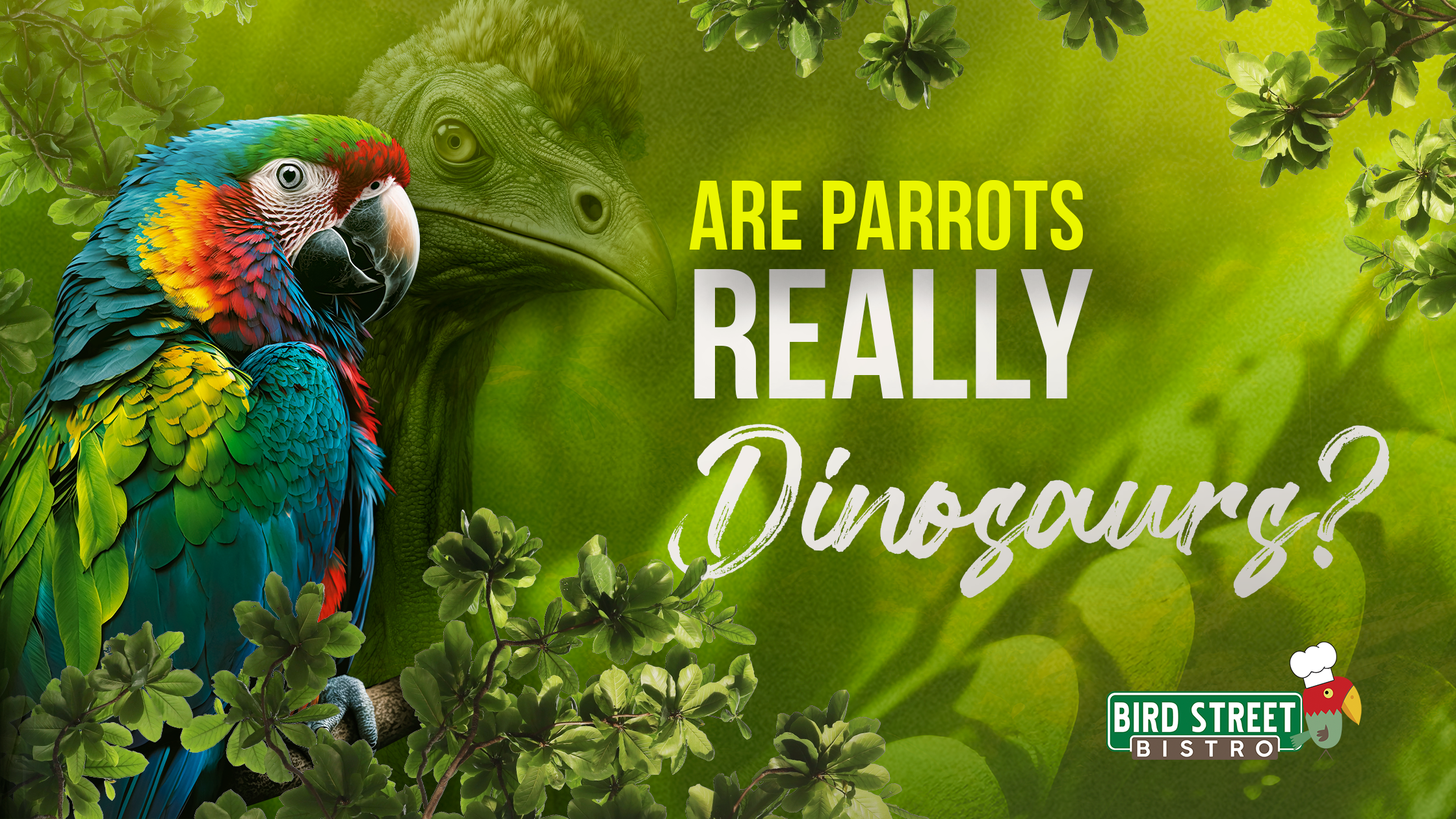Are Parrots Really Dinosaurs?
Humans have been fascinated by dinosaurs for as long as we can remember. They are these massive, other-worldly creatures, unlike anything we could ever imagine existing today. Sure, there are large animals on Earth today, but the portrait painted by scientists about what the world was like when dinosaurs roamed the earth is both frightening and fascinating. We could never imagine being able to see a dinosaur in our backyard or on our way to work. We especially can’t expect to see one soar across the sky or scream out to us from the other room in our home - or can we?

The Question and the Debate: Are Birds Related to Dinosaurs?
For years, there was a debate in the scientific community between those that believed birds evolved from earlier reptiles and those that say birds came from small dinosaurs called Theropods. Most of the debate came from how scientists interpreted fossils that they found, with proponents of the reptile side claiming that they did not see evidence to support the dinosaur theory. But those that did, argued that newly discovered fossils showed more and more that modern birds share many features with them. Today, it is generally considered that if an animal has feathers, walks on its toes and has a wishbone, then it is a bird. But millions of years ago, life wasn’t that simple. So, looking at fossils from that time and interpreting the connections isn’t as simple either. For example, most people would consider a pterodactyl to most closely resemble a modern bird. But they are not even related to birds! They’re actually just flying reptiles.
Although there is still some debate within a small section of the scientific community, as more discoveries are made, the consensus is now that the birds we see today come from a group of dinosaurs called Theropods. Theropods are bipedal saurischian dinosaurs, meaning they had 2 legs and a pelvis that pointed downward and forward like that of a crocodile. Some of the most famous Theropods included the Tyrannosaurus rex and velociraptors. Scientists made the connection when they discovered that some Theropods had traits that were very bird-like including feathers and three toes.

In 1970 paleontologists started to compare the fossil of Archaeopteryx, a fossil found to be about 150 million years old that had bird-like features, to the Theropod dinosaurs. (Image left, from The Berlin specimen of Archaeopteryx lithographica. Photo by H. Raab) They found that this animal had traits that appeared both reptilian and avian. There were other ancient fossils now considered to be ancient birds that also had avian and reptilian traits as well.
It wasn’t until the 1990s that new discoveries in China started to put even more pieces of the puzzle together. New fossils were discovered in lake beds that were shown to have had recognizable bird features like feathers and quills, and they also showed that the features of modern day birds actually developed slowly over time. One of those fossils is that of the Sinornis Santensis. This creature is now considered to be one of the very first birds that was capable of flight. These new fossils provide scientists with an intermediary link between the birds we know today and their first ancient ancestors. As more fossils are discovered, they can provide even more missing pieces to the gaps.
When you look at all of the facts, you realize that birds are remarkably good at surviving. For millions of years, they have found a way to thrive and exist on earth despite all of the challenges that existed including the devastating asteroid that changed everything on Earth.

Why Are Birds the Only Dinosaurs That Survived?
66 million years ago, an asteroid called Chicxulub slammed into the earth and destroyed about 75% of the animals on the planet including all non-bird dinosaurs. But how is it that birds were able to survive the devastation?
When the asteroid hit, dust clouds filled up the entire sky - blocking out the sunlight, triggering mega-tsunamis, and causing earthquakes that lasted months. All of this was bad enough but then came the heat. When the asteroid hit, rock and debris flew up into the air and created kinetic energy of about 20 million megatons. That energy was converted to heat as that rock and debris fell back to earth. Doug Robertson, a geologist at the University of Colorado said “For several hours following the Chicxulub impact, the entire Earth was bathed with intense infrared radiation from ballistically reentering ejecta.”
Only the smaller animals stood a chance at survival. Any animals that weren't able to take shelter or that weren’t underwater died as a result of the heat and devastation. Then came the impact on the climate. Dust and debris as a result of the impact created what has been called an “impact winter” because for about a year, sunlight was unable to reach the surface of the planet. Many animals that survived the initial impact were now starving because food sources were extremely scarce. Many plants couldn't survive the loss of adequate sunlight.

However, one group of dinosaurs survived everything. These were the avian dinosaurs, also known as birds. Not only did birds survive, but they are currently all over the planet in all different types of environments. Scientists believe there were a few contributing factors that helped them out. One is that these dinosaurs were smaller and smaller creatures tend to breed faster. Doing so makes it easier for them to adapt to new situations. Smaller animals also don’t need to eat as much as larger ones. Another contributing factor is that birds even back then likely had a wide variety of foods that they ate like seeds, fruit, and insects. Many could also fly, meaning they could escape bad conditions more easily.
According to the International Ornithological Committee, there are around 11,000 species of birds on Earth today. They can be found in all corners of the world and all different kinds of environments. Over millions of years, birds have become more diverse as a species and can be found on all seven continents. Although, sadly, so much of Earth’s life died when the asteroid hit, this provided avian dinosaurs an opportunity to flourish once conditions started to return to normal. Previous resources that weren’t as available due to competition from other dinosaurs were now easier to access.
So, yes, it seems that birds are dinosaurs - and by extension parrots as well. People used to think that dinosaurs went extinct, but they technically didn’t! It’s an amazing idea if you think about it. Especially when you know that birds are the 5th most popular pet in the United States. That means tons of families across the country have small dinosaurs living in their homes. So, every time your parrot gives you a little bite, you are getting savagely attacked by a powerful, savage dinosaur beast. Ok, maybe it's not quite that dramatic, but they certainly seem to see themselves that way sometimes!
Thank you for taking the time to learn about our feathered family members. For more information on Bird Street Bistro's line of delicious bird food, check out our website and delicious products - like the Hearty Veggies bistro blend.
References:
Morell, Virginia. “Fossilized Hatchling Heats Up the Bird-Dinosaur Debate.” Science, vol. 276, no. 5318, 1997, pp. 1501–1501. JSTOR, http://www.jstor.org/stable/2893450. 2023.
Dyke, G., & Kaiser, G. (2011). Living Dinosaurs : The Evolutionary History of Modern Birds. John Wiley & Sons, Incorporated.
"It’s Official: Birds Are Literally Dinosaurs. Here’s How We Know." BirdLife International, 21 Dec. 2021, www.birdlife.org/news/2021/12/21/its-official-birds-are-literally-dinosaurs-heres-how-we-know.
"How Dinosaurs Shrank and Became Birds." Scientific American, 12 Jun. 2015, www.scientificamerican.com/article/how-dinosaurs-shrank-and-became-birds. Accessed 1 Dec. 2023.
- Choosing a selection results in a full page refresh.
- Press the space key then arrow keys to make a selection.


